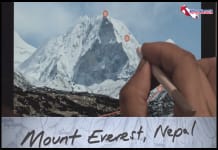For the past two years, we at Kathmandu Living Labs have been building community around OpenStreetMap, which is a free wiki map of the world.
One of the major reasons for building this community was that, we believed having a great map that is made by the locals themselves is a great help in building disaster resilience. We had mapped Kathmandu in great detail even before the earthquake struck, including all the school and health facilities in Kathmandu Valley along with their structural data and made it freely available to everyone in OpenStreetMap. We had started to expand our work to other cities like Bharatpur and Hetauda and also VDC’s like Bajrabarahi, Manahari, and Padampur. We went to these places and involved the local community in the mapping process. Farmers, students, and teachers in these villages mapped out their communities in great detail on the OpenStreetMap platform, including a Kiwi farmer in Bajrabarahi who single-handedly mapped all the kiwi farms in the village.

One of the reasons we had been building this map was to be prepared for the earthquake that was long predicted in Kathmandu. When the earthquake actually happened on 25th April, the International community stepped in to speed up our work in a big way! Almost 5000 national and international volunteers come together to help remotely map Nepal. On the other side, organizations ranging from International organizations like the Canadian Military, UN OCHA, World Food Programme and national organizations like the Survey Department and the Nepal Army have used the data from OpenStreetMap. Many of these are downloaded from http://quakerelief.info while others are using the data from OpenStreetMap to create their own maps. OpenStreetMap has become a default map from this crisis, and we are incredibly thankful to all of the volunteers that have contributed to the map.

The day after the earthquake struck, we also launched the QuakeMap.org platform platform where people can submit reports for earthquake related needs. 1800 reports have come into the system, which aggregates needs related to food, medicine, shelter, and sometimes even evacuations. We have a team of volunteers who then verifies many of those needs, and routes them to appropriate responding organizations. Responding organizations can, and do subscribe to alerts for new reports that come into the system. Many also ask us for spreadsheets aggregating certain categories of needs in certain areas that we are also able to provide organizations with. At the moment, our team of volunteers are focusing on which of the reported needs have been sufficiently addresses, and which of them haven’t, alerting appropriate organizations whenever unmet need is encountered. Our aim is to mark as many reports as possible as “action taken.”
Our work has been covered by national and international media like the New York Times, Wired, BBC, Nepali Times, Kantipur Television, and many more.
This has made us a central hub for map and GIS related resources. We are a small team and we need to quickly expand to cope with this increasing demand. At the same time we also are having to cope with issue of office space. Our office space at biruwa ventures has been damaged by earthquake. Kasthamandap School have provided us temporary space until the school starts but we need to relocate to continue our work.
Since we are firm believers of the power of the crowd we have launched a crowd funding campaign on Indiegogo (https://www.indiegogo.com/projects/maps-for-nepal ) to help us cope with the strain currently put to our team.
In order to make our campaign a success we need help as much help we can get. Please help us make maps for Nepal.
* Kathmandu Living Labs is a non profit tech company focusing on open source and civic use of technology.
















Wow.
u all are doing nice thing ….. i m with u all
Comments are closed.